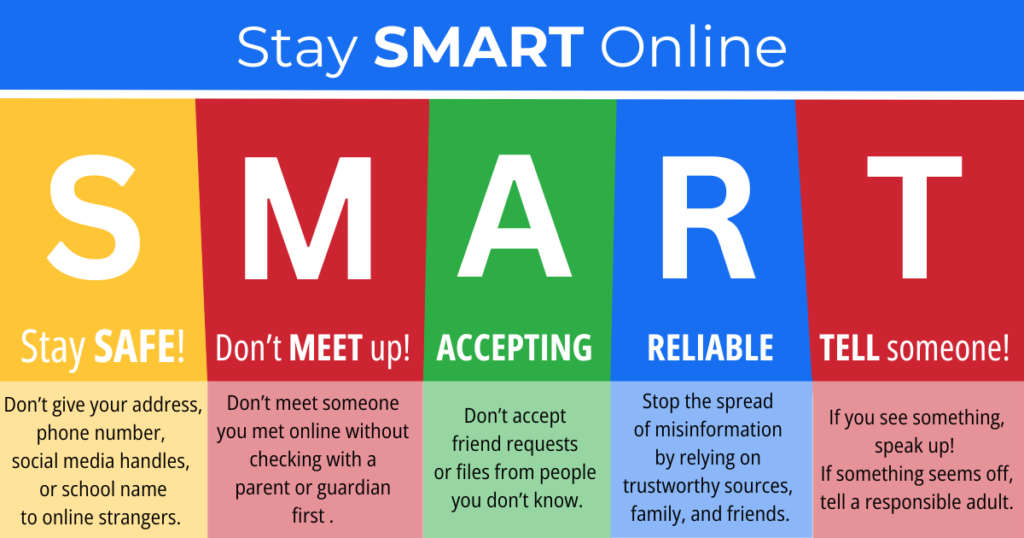With more than 175,000 children going online for the first time every day, internet safety for students is more important than ever.
While there are many safeguards in place, the internet is not inherently safe. A seemingly friendly sea of information and connections can quickly turn into a barren wasteland when personal information falls into the wrong hands or students are victims of cyberbullying.
As 94% of children have access to the internet, it’s crucial to equip your students with the skills they need to stay safe online. When you think of internet safety for students, think SMART.
What is SMART?
SMART is an effective pneumonic for students to remind them of internet safety best practices. While SMART can be used for kids of all ages (and adults for that matter too!), it’s especially helpful for younger students to practice, remember, and apply, and lays a great foundation. Older students can find more advanced safety tips in our guide to internet safety for high school students.

Stay Safe
The first key to staying safe online is keeping your personal information private. Students should never disclose personal information to strangers, especially unchaperoned. No exceptions. This includes name, address, phone number, social media handles, photos, and school name.
It’s crucial to remind students that it doesn’t matter how trustworthy the person may seem—a stranger is a stranger. As much as a student may think they know someone they met online, the reality is, they don’t.
Don’t Meet Up
Akin to keeping personal information private, is the importance of teaching students that meeting an online stranger in person can be extremely dangers. Students should always check with a parent or guardian about meeting an online stranger, and the parent or guardian should be present during all meetings. No matter what!
Again, this comes down to reminding students that you never really know who is on the other side of the screen. All it takes is one meeting alone for things to turn disastrous.
Accepting
This may be a difficult one for students to follow, but they should never accept friend or connection requests from people they don’t know. They should ask a parent or guardian first.
Likewise, they shouldn’t accept files (emails, texts, documents, and photos) from strangers either. Opening files from strangers can take damage their devices if the files are corrupted with a virus.
Remind students to block users they don’t know after receiving an unwanted file. This can be easily be done by blocking users under settings in both email and cellular services.
Reliable
This next key to internet safety for students is two pronged. As digital students, student need to do their part in stopping the spread of misinformation by verifying information with reliable sources prior to sharing it. Even if information isn’t shared, it’s always a good habit to compare the source to another to confirm its veracity. If something seems too good to be true, unusual, or extraordinary, chances are it is.
Reliability also extends to those students meet online. They should rely on those they already know and trust, like family and friends.
Tell Someone
Perhaps the most important key: if you see something, say something! Internet safety for students goes beyond the perils of stolen information. The internet is the virtual playground for cyberbullying. Create an honest and transparent environment where students feel comfortable to bring concerns to an adult, whether that be their teacher or parent.
Even if you create the most trusting environment in the world, students can still be deterred from bringing their concerns to an adult. This is why it’s so important to check in with students regularly about their online and social media habits. Pay attention to what they’re interested in online and who they are talking to. Limit access to certain sites to avoid potentially harmful situations.
Other Tips
In general, it’s so important for students to understand:
- The risks and rewards of the internets. It’s a great tool when used appropriately and safely.
- It’s very easy to lie online, and it happens more often than they might think. Someone they meet online is a stranger, period! It doesn’t make them good or bad, but someone the student simply does not know and should not easily trust.
- They should always check with an adult they trust if something doesn’t feel right.
Internet safety for students isn’t rocket science. It just requires education, diligence, and transparency. When used appropriately and safely, the internet is a great tool for research and social connection. For more advanced tips, check out our blog on internet safety for high school students.
From Chromebook parts to tech buyback, AGParts Education supports over 6,000+ school districts in their 1:1 device initiatives. For more info, contact us today!


Recent Comments